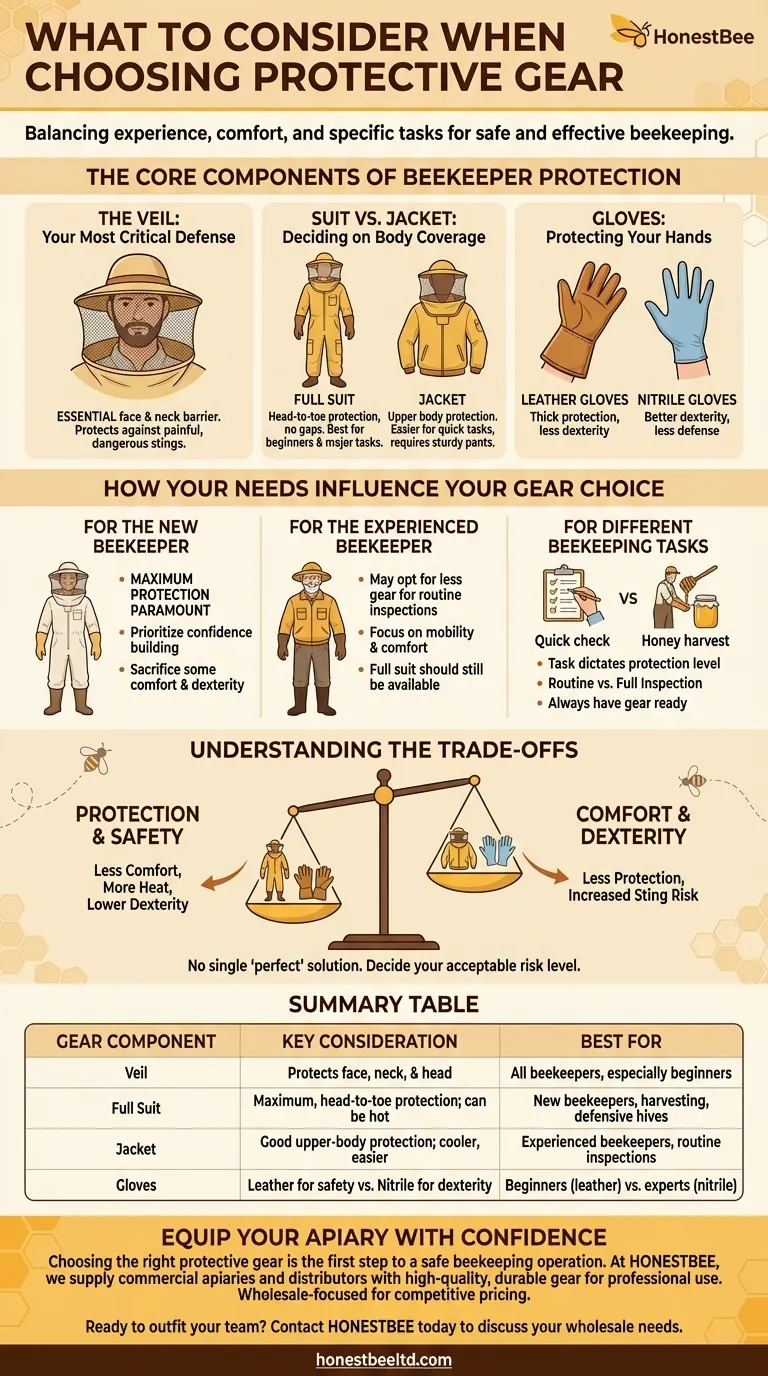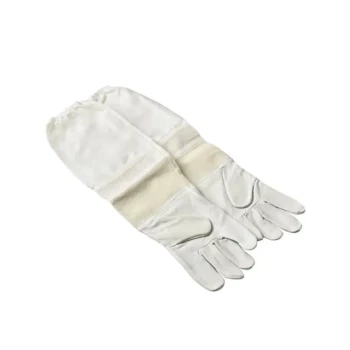When selecting beekeeping gear, the right choice depends on a careful balance of your experience level, personal comfort, and the specific tasks you need to perform. The essential components are a veil to protect your head and face, a suit or jacket for your body, and gloves for your hands. For new beekeepers, prioritizing maximum protection is the most reliable path to building confidence.
The ultimate goal of protective gear isn't just to prevent all stings, but to provide a level of security that allows you to work with your bees calmly and effectively. Your gear choice is the foundation of a safe and successful beekeeping experience.
The Core Components of Beekeeper Protection
Every piece of protective equipment serves a specific and critical function. Understanding these roles is the first step in assembling the right kit for your needs.
The Veil: Your Most Critical Defense
A high-quality hat and veil are universally considered the most important part of your gear. Stings to the face, especially near the eyes, nose, and mouth, are particularly painful and dangerous.
The veil provides an essential barrier for your head and neck, protecting these sensitive areas during any interaction with the hive, from a quick look to a full honey harvest.
Suit vs. Jacket: Deciding on Body Coverage
The choice between a full bee suit and a jacket is a significant one. A full suit offers head-to-toe protection, ensuring no gaps for bees to enter.
A jacket provides excellent protection for the upper body and is often combined with a built-in veil. It is easier to put on for quick tasks but requires you to provide your own sturdy pants and boots.
Gloves: Protecting Your Hands
Working inside a hive requires you to use your hands for delicate tasks. Gloves provide a crucial barrier against stings on your most-used tool.
While traditional leather gloves offer thick protection, many beekeepers prefer thinner nitrile gloves, which improve dexterity and feel, though they offer slightly less defense against a determined bee.
How Your Needs Influence Your Gear Choice
The "best" gear is entirely dependent on your personal context. A beginner's needs are fundamentally different from those of a seasoned expert.
For the New Beekeeper
If you are new to beekeeping, maximum protection is paramount. Starting with a full bee suit, a reliable veil, and gloves is strongly recommended.
This approach sacrifices some comfort and dexterity, but it provides the security needed to learn and build confidence without the negative experience of a major stinging incident.
For the Experienced Beekeeper
As experience grows, some beekeepers may opt for less gear for routine inspections. A jacket and veil combination is common for those who are comfortable with their hives and want more mobility and comfort.
However, even the most experienced keeper should have a full suit available.
For Different Beekeeping Tasks
The task at hand dictates the necessary level of protection. A quick check of a feeder might only warrant a veil, while a full hive inspection or honey harvest justifies wearing your complete protective outfit.
Understanding the Trade-offs
Choosing beekeeping gear is an exercise in balancing competing priorities. There is no single "perfect" solution.
Protection vs. Comfort
More coverage almost always means less comfort. Full bee suits can become very hot, especially during summer months, but they offer the highest level of security. You must decide what level of risk you are willing to accept in exchange for comfort.
Dexterity vs. Safety
Thick, sting-proof gloves offer excellent safety but can make it difficult to handle frames and equipment gently. Thinner gloves improve your sense of touch and control, but they increase the likelihood of hand stings.
The Risk of Complacency
It is crucial to remember that the temperament of a bee colony can change. A hive that is typically calm can become defensive due to weather, a nectar shortage, or other stressors. Always having your gear ready is a non-negotiable part of responsible beekeeping.
Making the Right Choice for Your Goal
Your selection should be a deliberate decision based on your primary objective.
- If your primary focus is building confidence as a beginner: Opt for a full bee suit, a reliable veil, and gloves to ensure maximum protection.
- If your primary focus is comfort during quick, routine inspections: A jacket with a built-in veil offers a practical balance of protection and convenience.
- If your primary focus is maximum dexterity for delicate tasks: Consider using thinner nitrile gloves, but understand and accept the increased risk of hand stings.
Ultimately, choosing the right gear is about empowering you to work calmly and effectively, ensuring both your safety and the well-being of your bees.
Summary Table:
| Gear Component | Key Consideration | Best For |
|---|---|---|
| Veil | Protects face, neck, and head; essential for all beekeepers. | All beekeepers, especially beginners. |
| Full Suit | Maximum, head-to-toe protection; can be hot. | New beekeepers, harvesting, defensive hives. |
| Jacket | Good upper-body protection; cooler and easier for quick tasks. | Experienced beekeepers, routine inspections. |
| Gloves | Leather for max safety vs. nitrile for better dexterity. | Beginners (leather) vs. experts (nitrile). |
Equip Your Apiary with Confidence
Choosing the right protective gear is the first step to a safe and productive beekeeping operation. At HONESTBEE, we supply commercial apiaries and beekeeping equipment distributors with high-quality, durable gear designed for professional use. Our wholesale-focused operations ensure you get the reliable protection you need at a competitive price.
Ready to outfit your team? Contact HONESTBEE today to discuss your wholesale needs and ensure every beekeeper is properly protected.
Visual Guide

Related Products
- Cotton Beekeeping Suit and Round Hat with Veil Bee Keeper Protective Gear
- Goatskin Leather Beekeeper Gloves with Vent Long Sleeve for Beekeeping Honey Bee Sting Proof Protection
- Heavy Duty Cowboy Beekeeper Hat with Visibility Veil Outdoor Professional Beekeeping Protective Gear
- Mesh Ventilated 3 Layer Goatskin Beekeepers Gloves for Beekeeping
- Beekeeper Cowboy Hat and Veil for Beekeeping
People Also Ask
- What are the benefits of a fully ventilated beekeeping suit? Stay Cool and Protected in Hot Climates
- What are bee suits made of? Choosing the Right Material for Maximum Protection & Comfort
- What factors should be considered when choosing a beekeeping suit? Balance Safety, Comfort & Performance
- How should a beekeeping suit be hung to maintain its shape? Protect Your Investment with Proper Storage
- Why is white the predominant color in bee suit designs? | Key to Hive Calm & Beekeeper Safety



















